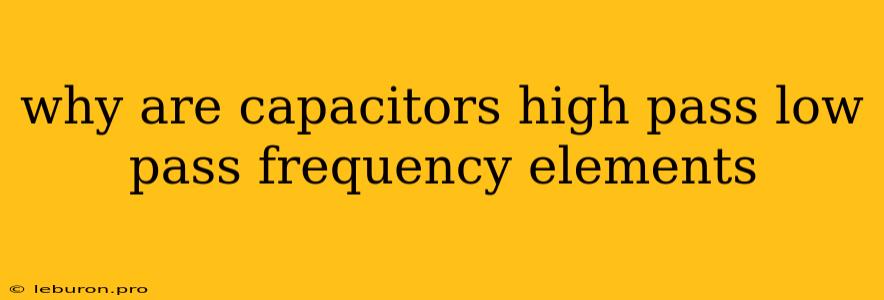Why are capacitors high-pass and low-pass frequency elements?
Capacitors are fundamental components in electronics, playing a crucial role in shaping the frequency response of circuits. Their ability to store electrical energy in an electric field allows them to act as high-pass or low-pass filters, selectively allowing certain frequencies to pass through while attenuating others. Understanding how capacitors interact with varying frequencies is crucial for designing effective circuits, particularly in applications such as audio processing, signal conditioning, and power filtering.
The Impedance of a Capacitor
The key to understanding why capacitors are high-pass or low-pass elements lies in their impedance. Impedance, analogous to resistance in DC circuits, represents the opposition a component offers to the flow of alternating current (AC). Unlike resistors, which have a constant impedance regardless of frequency, a capacitor's impedance changes with frequency. This characteristic behavior is directly linked to how a capacitor stores and releases electrical charge.
Capacitive Reactance: The Frequency Dependence
The impedance of a capacitor is known as capacitive reactance (Xc) and is inversely proportional to the frequency (f) of the AC signal:
Xc = 1 / (2πfC)
Where C represents the capacitance of the capacitor. This equation reveals that as the frequency increases, the capacitive reactance decreases. Conversely, at lower frequencies, the capacitive reactance is higher. This relationship is the cornerstone of capacitor behavior as a frequency-dependent element.
Capacitors as High-Pass Filters
When a capacitor is used in a circuit with a resistor, it forms a high-pass filter. In this configuration, the capacitor and resistor act as a voltage divider, with the output signal taken across the resistor.
How High-Pass Filtering Works
At high frequencies, the capacitive reactance is low. This means the capacitor offers little resistance to the flow of high-frequency signals, allowing them to pass through the filter with minimal attenuation. The output signal across the resistor is therefore similar in amplitude to the input signal.
On the other hand, at low frequencies, the capacitive reactance is high. The capacitor acts like an open circuit, blocking the low-frequency signals from reaching the resistor. Consequently, the output signal is significantly attenuated at low frequencies.
Applications of High-Pass Filters
High-pass filters find numerous applications in electronics, including:
- Audio circuits: To remove unwanted low-frequency noise or rumble from audio signals.
- Signal processing: To isolate specific frequency bands of interest.
- Power filtering: To suppress DC components from AC signals.
Capacitors as Low-Pass Filters
When a capacitor is placed in parallel with a load, it acts as a low-pass filter. The capacitor essentially shorts out high-frequency signals while allowing low frequencies to pass through to the load.
How Low-Pass Filtering Works
At low frequencies, the capacitive reactance is high. This allows the low-frequency signals to pass through the capacitor relatively unhindered, reaching the load.
However, at high frequencies, the capacitive reactance drops significantly. The capacitor effectively acts like a short circuit, bypassing the load and diverting the high-frequency signals to ground. The high-frequency components are therefore attenuated, resulting in a smoother, less noisy output signal.
Applications of Low-Pass Filters
Low-pass filters are commonly employed in:
- Audio circuits: To remove high-frequency noise and create a smoother, warmer sound.
- Power supplies: To smooth out the output of a rectifier, reducing ripple voltage.
- Signal conditioning: To prevent the passage of high-frequency noise or interference.
Conclusion
Capacitors exhibit frequency-dependent behavior due to their varying impedance. This impedance, known as capacitive reactance, decreases with increasing frequency. As a result, capacitors serve as high-pass filters, allowing high frequencies to pass through while blocking low frequencies, or low-pass filters, allowing low frequencies to pass while blocking high frequencies. Understanding the relationship between capacitor impedance and frequency is crucial for effectively utilizing capacitors in various electronic applications, shaping the frequency response of circuits, and filtering unwanted signals.
